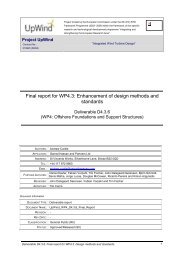You also want an ePaper? Increase the reach of your titles
YUMPU automatically turns print PDFs into web optimized ePapers that Google loves.
UPWIND<br />
turbines, as the differences in mean wind speed between the upwards and downwards moving<br />
blades are low.<br />
The wind speed distribution differs on- and offshore as well. It is typically described by a Weibull<br />
distribution with<br />
w<br />
�V� Page 14 of 146<br />
f<br />
�<br />
k<br />
A<br />
� V �<br />
� � �<br />
� A �<br />
� �<br />
� � V �<br />
� exp � � � �<br />
� �<br />
� � A � �<br />
k �1 k<br />
For offshore sites the scale parameter A tends to higher values and thus higher probabilities of<br />
higher wind speeds. Furthermore the shape of the distribution is defined by the parameter k and<br />
here larger values tend to more pronounced shapes.<br />
These differences in the wind speed distributions result in a higher power output and higher<br />
mean wind load level. For the prediction of energy yield of a wind turbine, long-term variations of<br />
the wind speed are significant, where in contrast for loads the short-term fluctuations are more<br />
relevant. Here the stochastic effects in the wind speed, namely the turbulence, and transient<br />
events like gusts are main contributors to fatigue and extreme loading.<br />
Turbulence is the momentary deviation from the mean wind speed. The extent of turbulence<br />
depends on several meteorological and geographical conditions like the atmospheric layering or<br />
the terrain. A measure for turbulence is the so called turbulence intensity I, which is defined as<br />
the ratio between of the standard deviation of the wind speed and the mean wind speed<br />
σ<br />
I �<br />
V<br />
1<br />
hub<br />
The turbulence intensity is correlated with the surface roughness of a turbine site and decreases<br />
with the height, as the influence of the surface decreases as well with the height.<br />
A further factor is that the turbulence intensity decreases with increasing wind speed. But this<br />
assumption is not directly valid for offshore locations, as through the nature of the ocean surface<br />
it is correlated with the wind conditions. Here the waves and therefore also the surface<br />
roughness is connected with the existent wind speeds and duration of the wind impact.<br />
Depending on the duration, a sea state can be fully or not fully developed. For higher wind<br />
speeds the effects of the wind-wave-correlation lead to a slightlincrease in turbulence caused by<br />
the increase in surface roughness.<br />
Another aspect for fluctuating wind speeds is the turbulence induced in wake conditions in a<br />
wind farm. Especially in dense wind park layouts wake effects play an important role. In a wind<br />
farm, a turbine experiences a superimposed turbulent wind coming from the ambient and the<br />
wake turbulence. Again, as offshore the ground roughness and thus also the ambient<br />
turbulence is lower than onshore, the mixture of ambient and wake-induced turbulence is less<br />
and therefore the wake fields remain longer in the atmosphere. This results in a higher loading<br />
from wake effects at offshore sites than compared to onshore sites at a fixed turbine distance.<br />
Here especially the partial wake operations can be critical. As the swept area of a turbine is only<br />
partly affected by a wake the load fluctuations are higher.<br />
In general, with respect to fatigue, ambient and wake-induced turbulence have a crucial<br />
influence. Through the permanently fluctuating wind speeds and loads, the number of load<br />
cycles is extremely large, which plays a major role in the operational stability.<br />
In terms of extremes, the effect of turbulence is not that important. Here the occurrence of<br />
certain transients is crucial. Offshore, the probability of extreme wind speeds, like gusts or wind<br />
(2.2)<br />
(2.3)











